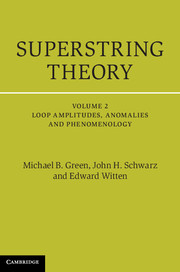Book contents
- Frontmatter
- Contents
- Preface to the 25th Anniversary Edition
- 8 One-loop diagrams in the bosonic string theory
- 9 One-loop diagrams in superstring theory
- 10 The gauge anomaly in type I superstring theory
- 11 Functional methods in the light-cone gauge
- 12 Some differential geometry
- 13 Low-energy effective action
- 14 Compactification of higher dimensions
- 15 Some algebraic geometry
- 16 Models of low-energy supersymmetry
- Bibliography
- References
- String Field Theory
- Index
8 - One-loop diagrams in the bosonic string theory
Published online by Cambridge University Press: 05 September 2012
- Frontmatter
- Contents
- Preface to the 25th Anniversary Edition
- 8 One-loop diagrams in the bosonic string theory
- 9 One-loop diagrams in superstring theory
- 10 The gauge anomaly in type I superstring theory
- 11 Functional methods in the light-cone gauge
- 12 Some differential geometry
- 13 Low-energy effective action
- 14 Compactification of higher dimensions
- 15 Some algebraic geometry
- 16 Models of low-energy supersymmetry
- Bibliography
- References
- String Field Theory
- Index
Summary
Our discussions of string scattering amplitudes in the first volume of this book were limited to tree diagrams. These are the lowest-order approximations to string scattering amplitudes. In principle, quantum corrections to the tree level or classical results should be obtained by a perturbation expansion derived from string quantum field theory. Our present state of knowledge does not make this possible. Historically, loop diagrams were constructed by using unitarity to construct loop diagrams from tree diagrams. This unitarization of the tree diagrams led, in time, to the topological expansion, as sketched in chapter 1.
As has been explained in chapters 1 and 7, the tree amplitudes for onmass-shell string states can be represented by functional integrals over Riemann surfaces that are topologically equivalent to a disk (for open strings) or a sphere (for closed strings). Higher-order corrections are identified with functional integrals over surfaces of higher genus. An important ingredient in the calculation of scattering amplitudes is the correlation function of vertex operators corresponding to the external particles emitted from the surface. The possible world-sheet topologies include surfaces with holes or “windows” cut out (for type I theories, where the surfaces have boundaries) or “handles” attached. For theories with oriented strings the surfaces must be orientable. Similarly, for theories containing only closed strings the surfaces must be closed.
- Type
- Chapter
- Information
- Superstring Theory25th Anniversary Edition, pp. 1 - 74Publisher: Cambridge University PressPrint publication year: 2012



